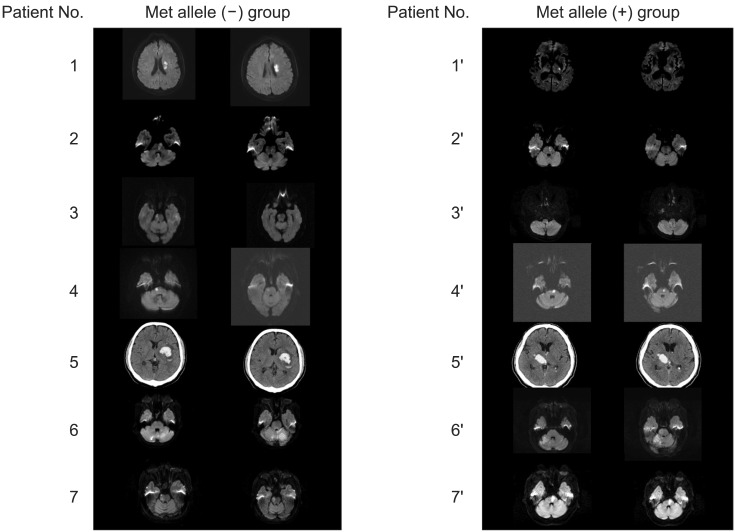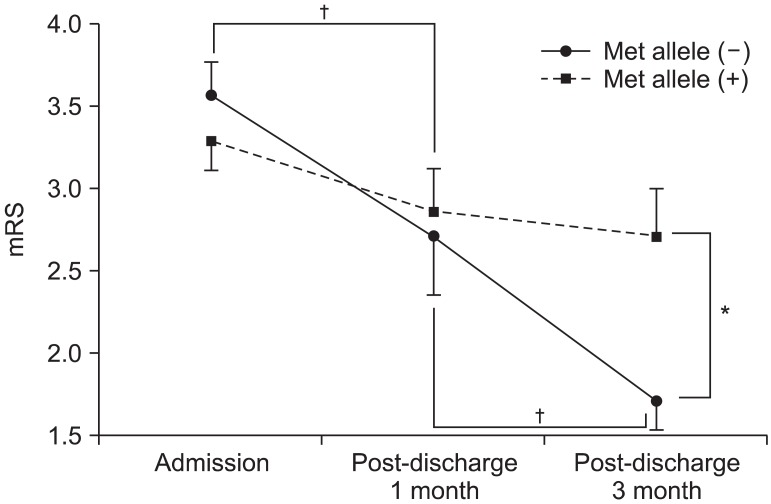Ann Rehabil Med.
2013 Jun;37(3):311-319. 10.5535/arm.2013.37.3.311.
Effect of the Presence of Brain-Derived Neurotrophic Factor Val66Met Polymorphism on the Recovery in Patients With Acute Subcortical Stroke
- Affiliations
-
- 1Department of Rehabilitation Medicine, Seoul National University Bundang Hospital, Seoul National University College of Medicine, Seongnam, Korea. njpaik@snu.ac.kr
- 2Department of Laboratory Medicine, Seoul National University Bundang Hospital, Seoul National University College of Medicine, Seongnam, Korea.
- KMID: 2219527
- DOI: http://doi.org/10.5535/arm.2013.37.3.311
Abstract
OBJECTIVE
To investigate the effect of brain-derived neurotrophic factor (BDNF) Val66Met polymorphism on the recovery after subcortical stroke, using the modified Rankin Scale (mRS).
METHODS
Subcortical stroke patients with copies of BDNF Val66Met polymorphism (n=7) were compared to their controls (n=7) without a copy of BDNF Val66Met polymorphism after matching for initial severity, location and type of stroke. The mRS scores at 1 and 3 months after discharge from the neurorehabilitation unit were compared between the groups.
RESULTS
A repeated measures ANOVA for mRS revealed significant interaction between time and group (F(2, 24) =37.2, p<0.001) and a significant effect of time (F(2, 24)=10.8, p<0.001), thereby reflecting significant differences between the Met allele (+) group and the Met allele (-) group. There was a significant difference in mRS scores at 3 months post-discharge between the two groups (p=0.01) although no difference was evident in mRS scores at 1 month post-discharge between the two groups. There were significant improvements between mRS scores on admission and mRS scores at 1 month post-discharge (p=0.02), and between mRS scores at 1 month post-discharge and mRS scores at 3 months post-discharge (p=0.004) in the Met allele (-) group.
CONCLUSION
BDNF Val66Met polymorphism may be associated with worse functional outcome in Korean patients with subcortical stroke. Therefore, BDNF Val66Met polymorphism should be considered as an important prognostic factor for recovery and responses to rehabilitation therapies after stroke in Korean patients. There is a need for developing different rehabilitation strategies for the population with BDNF Val66Met polymorphism. Further studies assessing different outcomes for various functional domains of stroke recovery are needed to clarify the role of BDNF Val66Met polymorphism.
MeSH Terms
Figure
Reference
-
1. Bonita R, Mendis S, Truelsen T, Bogousslavsky J, Toole J, Yatsu F. The global stroke initiative. Lancet Neurol. 2004; 3:391–393. PMID: 15207791.
Article2. Pearson-Fuhrhop KM, Cramer SC. Genetic influences on neural plasticity. PM R. 2010; 2(12 Suppl 2):S227–S240. PMID: 21172685.
Article3. Pearson-Fuhrhop KM, Kleim JA, Cramer SC. Brain plasticity and genetic factors. Top Stroke Rehabil. 2009; 16:282–299. PMID: 19740733.
Article4. Waters RJ, Nicoll JA. Genetic influences on outcome following acute neurological insults. Curr Opin Crit Care. 2005; 11:105–110. PMID: 15758588.
Article5. Egan MF, Kojima M, Callicott JH, Goldberg TE, Kolachana BS, Bertolino A, et al. The BDNF val66met polymorphism affects activity-dependent secretion of BDNF and human memory and hippocampal function. Cell. 2003; 112:257–269. PMID: 12553913.
Article6. Kleim JA, Chan S, Pringle E, Schallert K, Procaccio V, Jimenez R, et al. BDNF val66met polymorphism is associated with modified experience-dependent plasticity in human motor cortex. Nat Neurosci. 2006; 9:735–737. PMID: 16680163.
Article7. Shimizu E, Hashimoto K, Iyo M. Ethnic difference of the BDNF 196G/A (val66met) polymorphism frequencies: the possibility to explain ethnic mental traits. Am J Med Genet B Neuropsychiatr Genet. 2004; 126B:122–123. PMID: 15048661.
Article8. Cramer SC, Procaccio V. GAIN Americas. GAIN International Study Investigators. Correlation between genetic polymorphisms and stroke recovery: analysis of the GAIN Americas and GAIN International Studies. Eur J Neurol. 2012; 19:718–724. PMID: 22221491.
Article9. Westbroek EM, Pawlikowska L, Lawton MT, McCulloch CE, Young WL, Kim H. Brain-derived neurotrophic factor Val66Met polymorphism predicts worse functional outcome after surgery in patients with unruptured brain arteriovenous malformation. Stroke. 2012; 43:2255–2257. PMID: 22773554.
Article10. Siironen J, Juvela S, Kanarek K, Vilkki J, Hernesniemi J, Lappalainen J. The Met allele of the BDNF Val66Met polymorphism predicts poor outcome among survivors of aneurysmal subarachnoid hemorrhage. Stroke. 2007; 38:2858–2860. PMID: 17761923.
Article11. Garte S. The role of ethnicity in cancer susceptibility gene polymorphisms: the example of CYP1A1. Carcinogenesis. 1998; 19:1329–1332. PMID: 9744524.
Article12. Hamajima N, Matsuo K, Saito T, Hirose K, Inoue M, Takezaki T, et al. Gene-environment Interactions and Polymorphism Studies of Cancer Risk in the Hospital-based Epidemiologic Research Program at Aichi Cancer Center II (HERPACC-II). Asian Pac J Cancer Prev. 2001; 2:99–107. PMID: 12718640.13. Shelton FN, Reding MJ. Effect of lesion location on upper limb motor recovery after stroke. Stroke. 2001; 32:107–112. PMID: 11136923.
Article14. Chen CL, Tang FT, Chen HC, Chung CY, Wong MK. Brain lesion size and location: effects on motor recovery and functional outcome in stroke patients. Arch Phys Med Rehabil. 2000; 81:447–452. PMID: 10768534.
Article15. Paolucci S, Antonucci G, Grasso MG, Bragoni M, Coiro P, De Angelis D, et al. Functional outcome of ischemic and hemorrhagic stroke patients after inpatient rehabilitation: a matched comparison. Stroke. 2003; 34:2861–2865. PMID: 14615613.16. Johnston KC, Barrett KM, Ding YH, Wagner DP. Acute Stroke Accurate Prediction Investigators. Clinical and imaging data at 5 days as a surrogate for 90-day outcome in ischemic stroke. Stroke. 2009; 40:1332–1333. PMID: 19228853.
Article17. Rossini PM, Barker AT, Berardelli A, Caramia MD, Caruso G, Cracco RQ, et al. Non-invasive electrical and magnetic stimulation of the brain, spinal cord and roots: basic principles and procedures for routine clinical application. Report of an IFCN committee. Electroencephalogr Clin Neurophysiol. 1994; 91:79–92. PMID: 7519144.
Article18. Lee SY, Lim JY, Kang EK, Han MK, Bae HJ, Paik NJ. Prediction of good functional recovery after stroke based on combined motor and somatosensory evoked potential findings. J Rehabil Med. 2010; 42:16–20. PMID: 20111839.
Article19. Sozmen EG, Kolekar A, Havton LA, Carmichael ST. A white matter stroke model in the mouse: axonal damage, progenitor responses and MRI correlates. J Neurosci Methods. 2009; 180:261–272. PMID: 19439360.
Article20. Pantoni L, Garcia JH, Gutierrez JA. Cerebral white matter is highly vulnerable to ischemia. Stroke. 1996; 27:1641–1646. PMID: 8784142.
Article21. Dimou L, Simon C, Kirchhoff F, Takebayashi H, Götz M. Progeny of Olig2-expressing progenitors in the gray and white matter of the adult mouse cerebral cortex. J Neurosci. 2008; 28:10434–10442. PMID: 18842903.
Article22. Grefkes C, Fink GR. Reorganization of cerebral networks after stroke: new insights from neuroimaging with connectivity approaches. Brain. 2011; 134(Pt 5):1264–1276. PMID: 21414995.
Article23. Bosnell RA, Kincses T, Stagg CJ, Tomassini V, Kischka U, Jbabdi S, et al. Motor practice promotes increased activity in brain regions structurally disconnected after subcortical stroke. Neurorehabil Neural Repair. 2011; 25:607–616. PMID: 21646444.
Article24. Cramer SC. Repairing the human brain after stroke: I. Mechanisms of spontaneous recovery. Ann Neurol. 2008; 63:272–287. PMID: 18383072.
Article25. Banks JL, Marotta CA. Outcomes validity and reliability of the modified Rankin scale: implications for stroke clinical trials: a literature review and synthesis. Stroke. 2007; 38:1091–1096. PMID: 17272767.26. Frankel MR, Morgenstern LB, Kwiatkowski T, Lu M, Tilley BC, Broderick JP, et al. Predicting prognosis after stroke: a placebo group analysis from the National Institute of Neurological Disorders and Stroke rt-PA Stroke Trial. Neurology. 2000; 55:952–959. PMID: 11061250.
Article27. Sablot D, Belahsen F, Vuillier F, Cassarini JF, Decavel P, Tatu L, et al. Predicting acute ischaemic stroke outcome using clinical and temporal thresholds. ISRN Neurol. 2011; 2011:354642. PMID: 22462018.
Article28. Wade DT, Skilbeck CE, Hewer RL. Predicting Barthel ADL score at 6 months after an acute stroke. Arch Phys Med Rehabil. 1983; 64:24–28. PMID: 6849630.29. Ploughman M, Windle V, MacLellan CL, White N, Dore JJ, Corbett D. Brain-derived neurotrophic factor contributes to recovery of skilled reaching after focal ischemia in rats. Stroke. 2009; 40:1490–1495. PMID: 19164786.
Article30. Miyajima F, Ollier W, Mayes A, Jackson A, Thacker N, Rabbitt P, et al. Brain-derived neurotrophic factor polymorphism Val66Met influences cognitive abilities in the elderly. Genes Brain Behav. 2008; 7:411–417. PMID: 17973920.
Article31. van Swieten JC, Koudstaal PJ, Visser MC, Schouten HJ, van Gijn J. Interobserver agreement for the assessment of handicap in stroke patients. Stroke. 1988; 19:604–607. PMID: 3363593.
Article32. Kwon S, Hartzema AG, Duncan PW, Min-Lai S. Disability measures in stroke: relationship among the Barthel Index, the Functional Independence Measure, and the Modified Rankin Scale. Stroke. 2004; 35:918–923. PMID: 14976324.
- Full Text Links
- Actions
-
Cited
- CITED
-
- Close
- Share
- Similar articles
-
- An Association Study of the Brain-Derived Neurotrophic Factor Val66Met Gene Polymorphism and Schizophrenia
- A BDNF Val66Met Polymorphism and Ketamine-induced Rapid Antidepressant Action
- Association of the Brain-derived Neurotrophic Factor Gene and Clinical Features of Bipolar Disorder in Korea
- Association Study Between Brain-Derived Neurotrophic Factor Genetic Polymorphism and Treatment Responses of Selective Serotonin Reuptake Inhibitor in Major Depressive Disorder
- Brain-derived Neurotrophic Factor Is Associated with Cognitive Impairment in Elderly Korean Individuals



